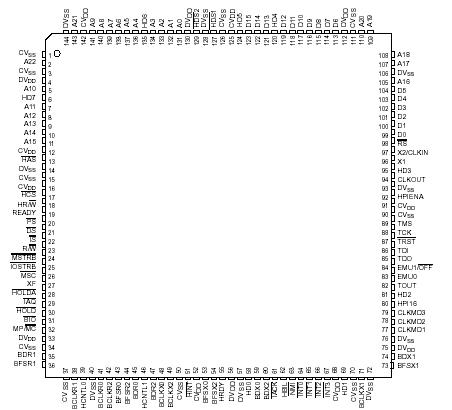Features: ` Advanced Multibus Architecture With Three Separate 16-Bit Data Memory Buses and One Program Memory Bus
` 40-Bit Arithmetic Logic Unit (ALU) Including 40-Bit Barrel Shifter and Two Independent 40-Bit Accumulators
` 17- *17-Bit Parallel Multiplier Coupled to 40-Bit Dedicated Adder for Non-Pipelined Single-Cycle Multiply/Accumulate (MAC) Operation
` Compare, Select, and Store Unit (CSSU) for Add/Compare Selection of the Viterbi Operator
` Exponent Encoder to Compute an Exponent Value of a 40-Bit Accumulator Value in a Single Cycle
` Two Address Generators With Eight Auxiliary Registers and Two Auxiliary Register Arithmetic Units (ARAUs)
` Data Bus With a Bus Holder Feature
` Extended Addressing Mode for 8M*16-Bit Maximum Addressable External Program Space
` 32K x 16-Bit On-Chip RAM Composed of:
Four Blocks of 8K ´ 16-Bit On-Chip Dual-Access Program/Data RAM
` 16K *16-Bit On-Chip ROM Configured for Program Memory
` Enhanced External Parallel Interface (XIO2)
` Single-Instruction-Repeat and Block-Repeat Operations for Program Code
` Block-Memory-Move Instructions for Better Program and Data Management
` Instructions With a 32-Bit Long Word Operand
` Instructions With Two- or Three-Operand Reads
` Arithmetic Instructions With Parallel Store Parallel Load
` Conditional Store Instructions
` Fast Return From Interrupt
` On-Chip Peripherals
Software-Programmable Wait-State Generator and Programmable Bank-Switching
On-Chip Programmable Phase-Locked Loop (PLL) Clock Generator With Internal Oscillator or External Clock Source(1)
One 16-Bit Timer
Six-Channel Direct Memory Access (DMA) Controller
Three Multichannel Buffered Serial Ports (McBSPs)
8/16-Bit Enhanced Parallel Host-Port Interface (HPI8/16)
` Power Consumption Control With IDLE1, IDLE2, and IDLE3 Instructions With Power-Down Modes
` CLKOUT Off Control to Disable CLKOUT
` On-Chip Scan-Based Emulation Logic, IEEE Std 1149.1 (JTAG) Boundary Scan Logic (2)
` 144-Pin Ball Grid Array (BGA) (GGU Suffix)
` 144-Pin Low-Profile Quad Flatpack (LQFP) (PGE Suffix)
` 6.25-ns Single-Cycle Fixed-Point Instruction Execution Time (160 MIPS)
` 8.33-ns Single-Cycle Fixed-Point Instruction Execution Time (120 MIPS)
` 3.3-V I/O Supply Voltage (160 and 120 MIPS)
` 1.6-V Core Supply Voltage (160 MIPS)
` 1.5-V Core Supply Voltage (120 MIPS)
(1) The on-chip oscillator is not available on all 5409A devices. For applicable devices, see the TMS320VC5409A Digital Signal Processor Silicon Errata (literature number SPRZ186).
(2) IEEE Standard 1149.1-1990 Standard-Test-Access Port and Boundary Scan Architecture.
Pinout SpecificationsDVDD Supply voltage I/O range . . . . . . . . . . . . . . . . . . . . . . . . . . 0.3 V to 4.0 V
SpecificationsDVDD Supply voltage I/O range . . . . . . . . . . . . . . . . . . . . . . . . . . 0.3 V to 4.0 V
CVDD Supply voltage core range . . . . . . . . . . . . . . . . . . . . . . . . . 0.3 V to 2.0 V
VI Input voltage range . . . . . . . . . . . . . . . . . . . . . . . . . . . . . . . 0.3 V to 4.5 V
VO Output voltage range . . . . . . . . . . . . . . . . . . . . . . . . . . . . . 0.3 V to 4.5 V
TC Operating case temperature range . . . . . . . . . . . . . . . . . 40°C to 100°C
Tstg Storage temperature range . . . . . . . . . . . . . . . . . . . . . . 55°C to 150°CDescriptionThe TMS320VC5409A fixed-point, digital signal processor (DSP) (hereafter referred to as the TMS320VC5409A unless otherwise specified) is based on an advanced modified Harvard architecture that has one program memory bus and three data memory buses. This processor TMS320VC5409A provides an arithmetic logic unit (ALU) with a high degree of parallelism, application-specific hardware logic, on-chip memory, and additional on-chip peripherals. The basis of the operational flexibility and speed of this DSP is a highly specialized instruction set.
Separate program and data spaces allow simultaneous access to program instructions and data, providing a high degree of parallelism. Two read operations and one write operation can be performed in a single cycle. Instructions with parallel store and application-specific instructions can fully utilize this architecture. In addition, data can be transferred between data and program spaces. Such parallelism supports a powerful set of arithmetic, logic, and bit-manipulation operations that can all be performed in a single machine cycle. The 5409A also includes the control mechanisms to manage interrupts, repeated operations, and function calls.

 TMS320VC5409A Data Sheet
TMS320VC5409A Data Sheet







